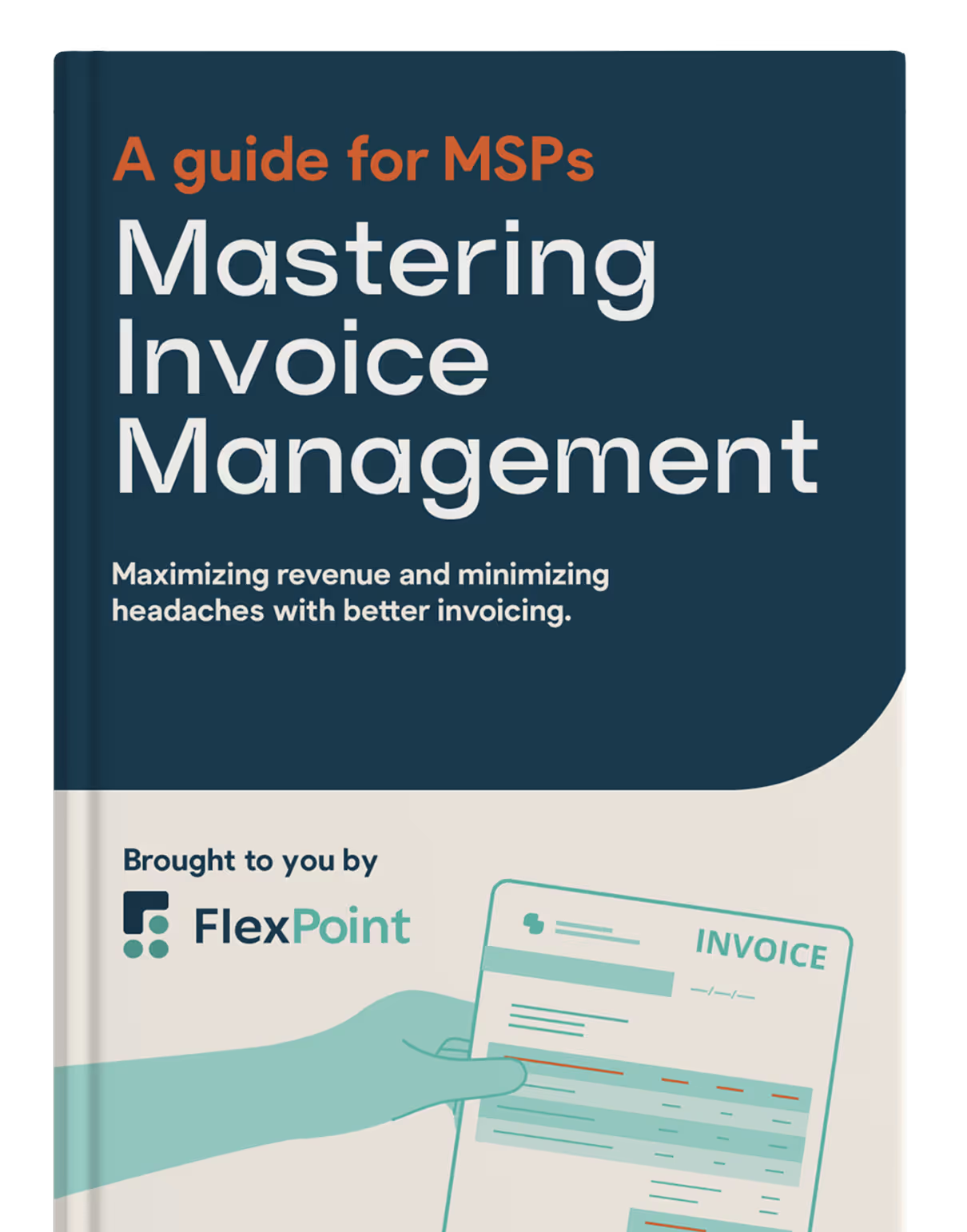How Transparent Billing Strengthens MSP Client Relationships
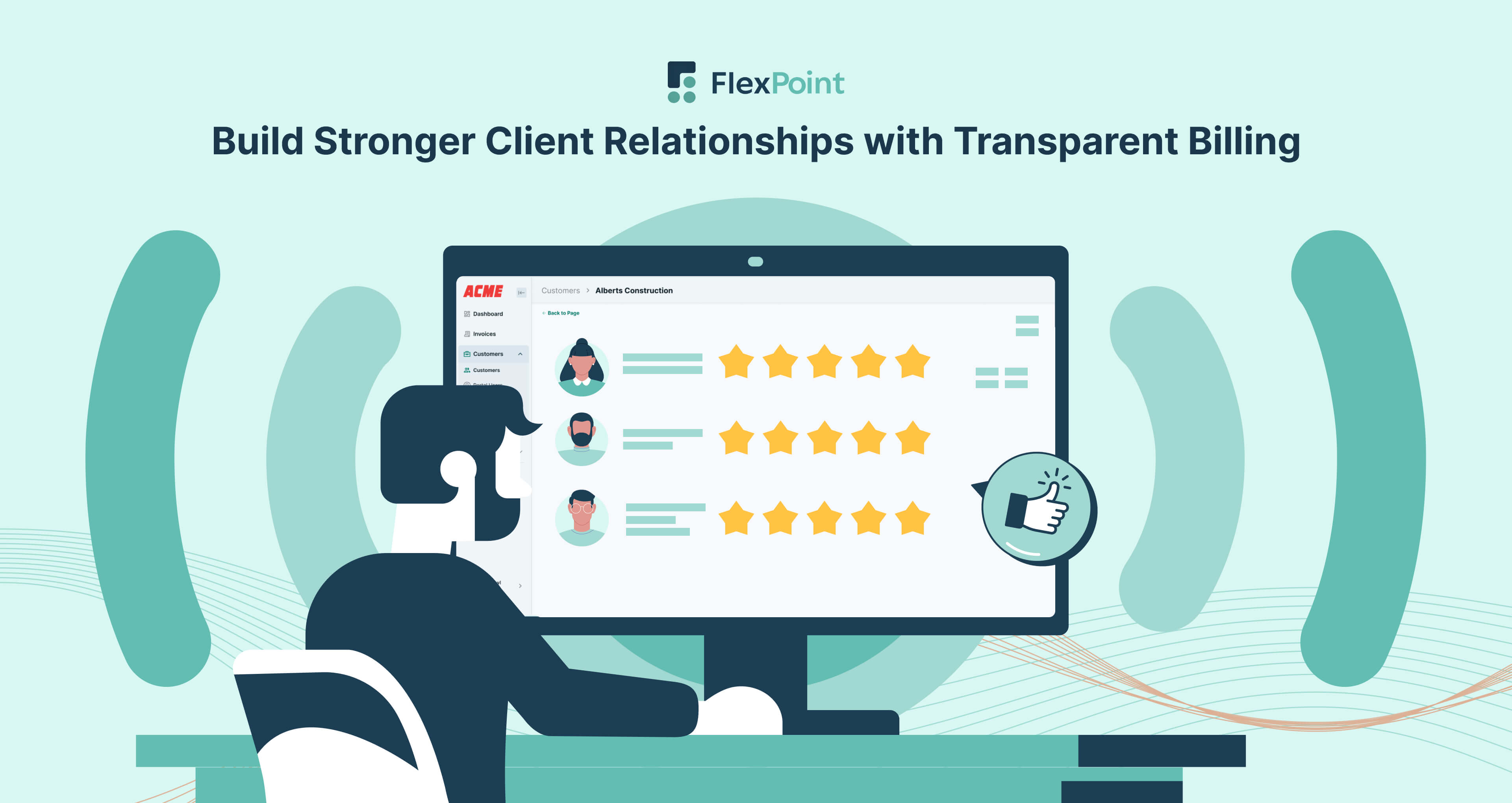
According to Versapay, 82% of companies lose clients due to payment miscommunications. Unclear invoices, billing errors, and unpredictable charges can create friction, leading to delayed payments or client churn.
Client trust is pivotal for an MSP’s success. In addition to superior service and solving client problems, MSPs must streamline billing practices to improve client relationships.
A comprehensive billing solution automates invoicing, minimizes payment disputes, and builds client trust. Itemized invoices and flexible payment options improve transparency and reduce payment friction. According to McKinsey, higher client satisfaction reduces the service cost by 10 to 20% and grows revenue by 10 to 15%.
In this article, we will discuss how MSPs can benefit from automated, transparent, and predictable billing. We will also look at strategies and best practices for MSPs to streamline their billing process and improve client relationships.
{{toc}}
The Connection Between MSP Billing and Client Relationships
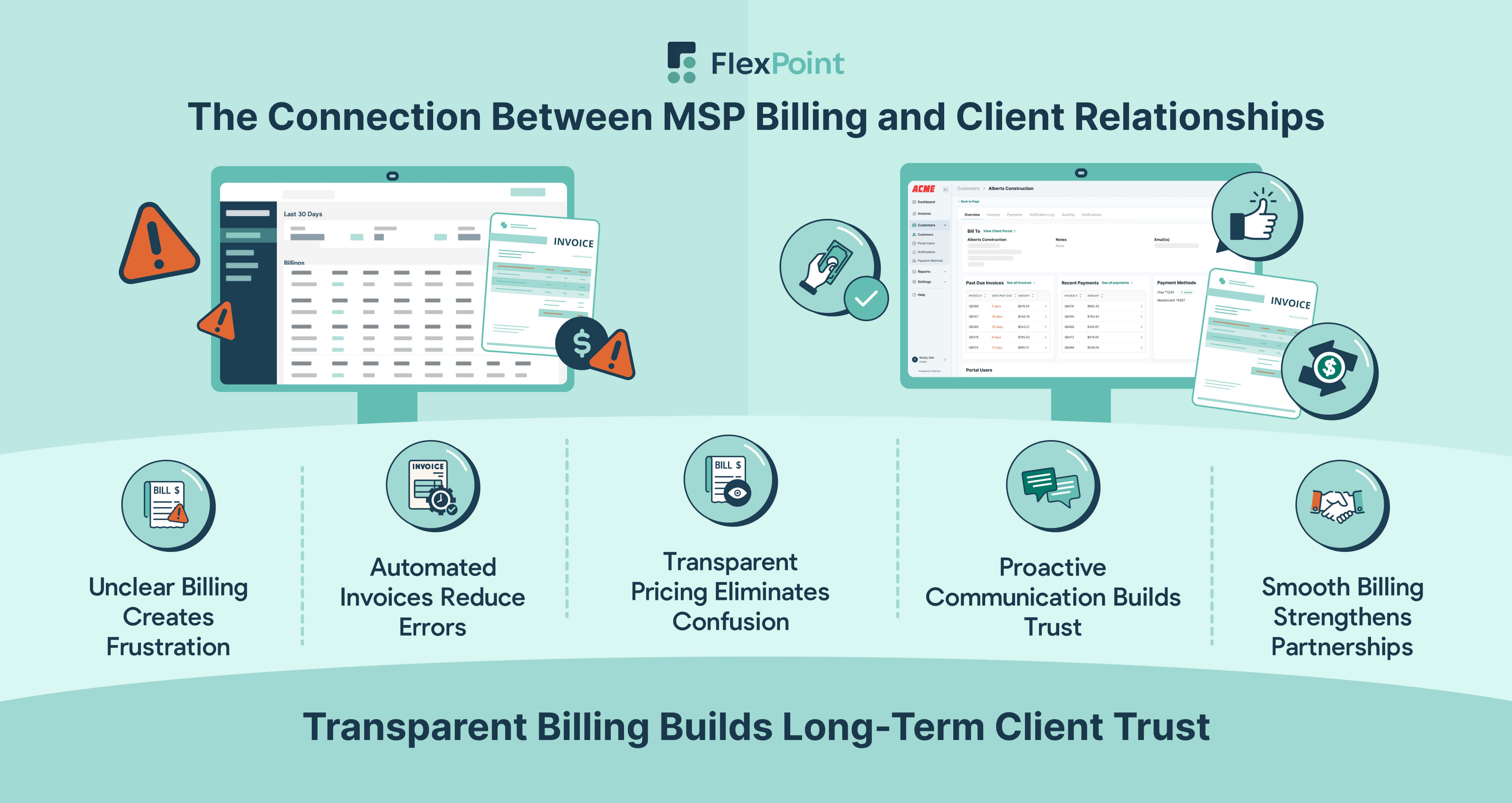
Many MSPs view billing as an administrative task, separate from the client experience. However, every invoice must reflect professionalism, reliability, and transparency.
Effective MSP billing management builds trust and strengthens long-term client relationships. However, poor billing practices, such as unclear invoices, inconsistent pricing, and unexpected charges, create client frustration.
According to Zuora, 39% of clients may switch to a competitor due to non-transparency in billing. Payment disputes strain client relationships and damage your MSP’s reputation.
MSPs should use automated invoicing, transparent pricing, and proactive communication to improve client relationships.
Automated billing ensures bills are sent on time and without errors, reducing manual work and avoiding disputes. Transparent pricing helps clients understand what they are paying for, eliminating confusion.
Proactive communication, such as notifying clients about upcoming invoices or pricing changes, shows accountability, improves client experience, and strengthens client trust.
According to Microsoft Dynamics 365, 95% of satisfied clients stay loyal to a business or brand. Efficient billing helps your MSP reduce payment issues, improve client satisfaction, and build stronger, long-term partnerships. A smooth billing process makes your MSP reliable and professional.
{{ebook-cta}}
5 Strategies and Best Practices to Strengthen MSP Client Relationships Through Billing
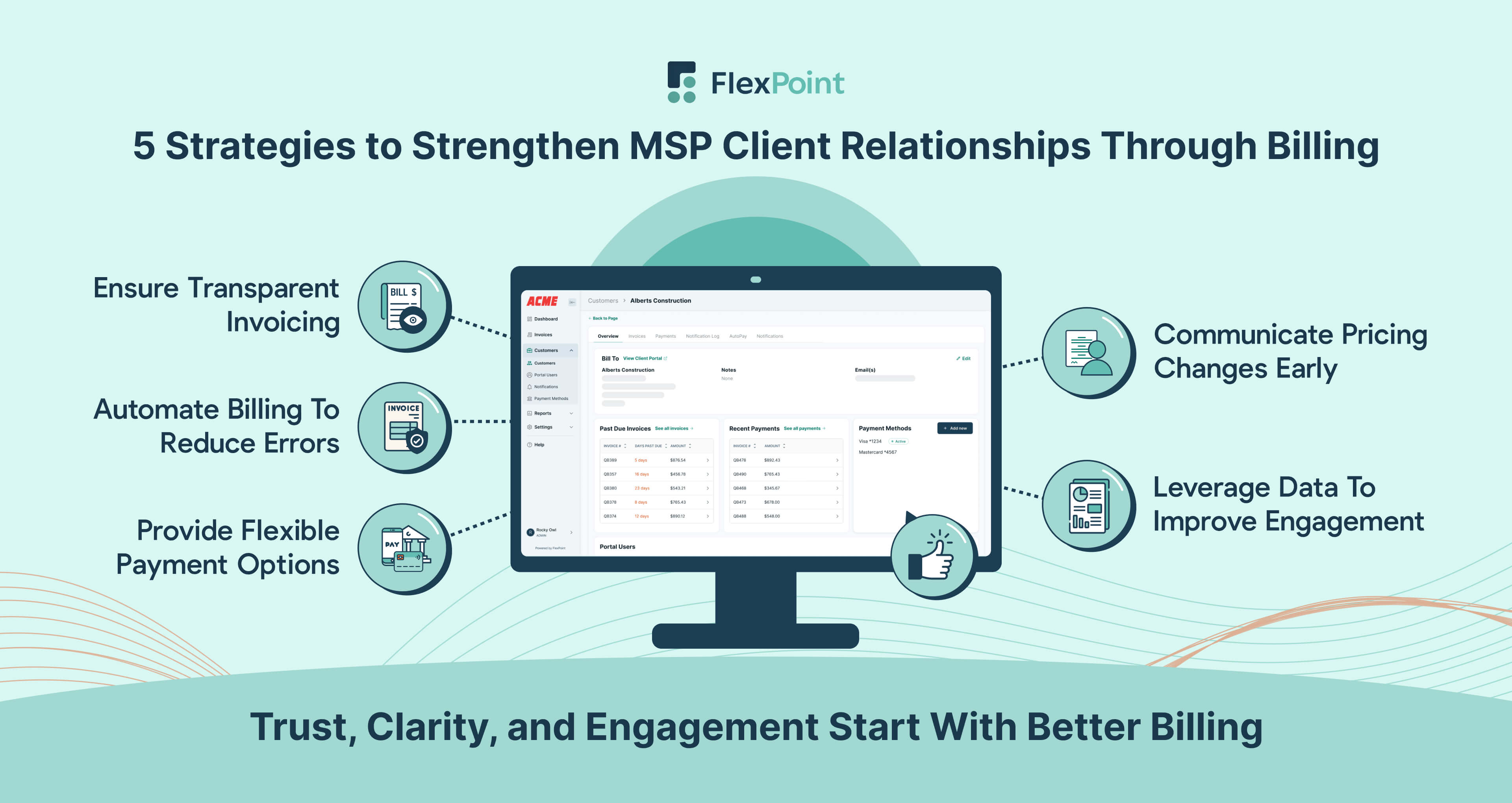
According to Smarter MSP, 80% of businesses think they have excellent customer service, but only 8% of customers believe the same. MSPs must improve their billing practices to improve client experience.
Clients with recurring billing issues might cancel subscriptions, avoid referrals, and switch to competitors when they notice and experience poor payment processes due to a lack of care for their business.
Simplifying payments and enhancing billing also saves time and resources spent on disputes.
Here are some actionable billing strategies and best practices to enhance trust, communication, and client satisfaction.
1. Ensuring Transparency in Invoicing to Build Trust:
According to Deloitte, 48% of B2B customers struggle to find accurate pricing information and get frustrated. Clients want to know what they are paying for, and unclear invoices can cause frustration and disputes.
Clear and itemized invoices give a detailed breakdown of services, making it easy for clients to verify charges. Itemized invoices provide clarity by detailing charges like licenses, maintenance, or service fees.
A well-structured invoice eliminates uncertainty, so clients might not feel they are being overcharged or billed unfairly. Unnecessary disputes can erode trust.
Clear and itemized invoices provide a detailed breakdown of licenses, maintenance, or service fees. A well-structured invoice is easier for clients to verify and prevents disputes due to uncertainty.
According to Zuora, 39% of clients switch to competitors due to hidden charges. Unexplained fees, vague descriptions, or undisclosed rate fluctuations can make clients suspicious.
However, including descriptions of services, billing periods, and applicable discounts provides clarity, and payments are processed faster.
You must also communicate upfront pricing adjustments, service modifications, or additional costs. Fair and consistent billing reduces misunderstandings and strengthens client relationships.
2. Automating Billing to Reduce Confusion and Errors:
According to OroCommerce, billing errors cause 60% of late payments, with 61% of invoices containing at least one.
Manual billing is prone to errors such as incorrect calculations, missing charges, duplicate line items, or misapplied discounts. These mistakes cause confusion, billing disputes, delayed payments, and reduced client trust.
Clients may question charges if invoices do not match agreements, leading to unnecessary back-and-forth. This delays payments and adds extra work for both the MSP and the client.

According to Regpack, identifying and correcting billing errors takes between three to seven days.
Automating invoicing solves common challenges by generating invoices quickly, accurately, and consistently. Automated invoicing systems use real-time service data, apply correct pricing by referring to agreement terms, and follow a standardized format. They eliminate errors, ensure all billable services are included, and prevent disputes from miscalculations or missing details.
Automation also boosts efficiency by scheduling recurring invoices, sending client reminders, and applying late fees based on pre-defined rules. It streamlines billing, improves cash flow, and reduces the need for manual work.
Many systems also integrate multiple payment options and real-time payment reconciliation to enhance the billing experience. A smooth and reliable billing process builds trust and strengthens long-term relationships.
3. Providing Flexible Payment Options for Client Convenience:
According to Hokodo, 86% of B2B customers choose vendors based on payment terms, and 83% abandon purchases if they do not find their preferred option.
A one-size-fits-all approach to payments is unsuitable as clients may have different financial structures and varying ways of managing expenses. Some clients rely on credit cards for their operational costs, while others prefer ACH transfers or direct bank payments.
Besides convenience, some clients may have internal approval workflows for specific payment methods, which may delay payments.

According to PYMNTS, 40% of companies cite invoice validation issues as the reason for late payments. Offering diverse payment options encourages faster payments and improves cash flow by allowing clients to choose their preferred method.
Modern payment solutions also enhance security and transparency as automated billing platforms provide real-time tracking, confirmations, and digital receipts.
A client-specific portal gives both parties clear visibility into payment statuses. Clients value updates about their pending, upcoming, and processed payments without following up with the MSP.

According to Flywire, 76% of companies suffer revenue loss due to time spent managing accounts receivable.
Automated payment options, such as recurring billing for subscription-based services and FlexPoint’s AutoPay, ensure operational efficiency for your MSP. You can improve cash flow with timely collections without requiring constant follow-ups.
4. Proactive Communication About Pricing and Billing Changes:
Non-transparent billing changes, like price hikes, extra service fees, changes in contract terms, or revoking discounts, can lead to client frustration and disputes. If these changes are not communicated clearly, clients can feel cheated and lose confidence in your MSP.
Clients may start seeking providers with more predictable billing if an MSP frequently changes prices without notifying them.
To avoid these challenges, MSPs should use a clear, proactive communication strategy for price changes, new fees, or contract renewals. Here are some best practices:
- Clearly Explain the Reasons for Changes: Provide a clear and logical explanation for billing changes. For example, if you are increasing fees, explain if it is due to rising costs or expanded services. Offering context helps clients understand the need for change.
- Provide Advance Notice: According to The ChannelPro Network, MSPs should notify clients of pricing changes at least 60 to 90 days in advance to show respect for their financial planning. This gives clients time to review and adjust their budgets, reducing potential disagreements, disputes, and chargebacks.
- Highlight the Value Clients Receive: Emphasizing enhanced services, better security, or improved support can make the pricing change easier to accept. Clients are less likely to object if they see a clear link between higher prices and better service.
5. Leveraging Data to Improve Client Engagement and Satisfaction:
Billing data provides key insights into client behavior, payment patterns/trends, and engagement.
Patterns in payment timeliness, disputes, and service use reveal client satisfaction and financial health. For example:
- Late payments may indicate cash flow challenges on the client’s end or dissatisfaction with the service. Identifying recurring late payers allows MSPs to engage proactively by offering flexible payment options or renegotiating terms to reduce friction.
- Frequent disputes or charge inquiries might signal unclear invoices or pricing misalignment. If clients repeatedly question charges, MSPs can adjust the breakup of billing details or improve pre-billing communication.
- Service upgrades or downgrades can show client sentiment. If multiple clients are scaling back services, it could indicate concerns about cost or service quality, whereas increasing service adoption suggests strong perceived value.
Analyzing billing data helps MSPs address client needs, improve financial processes, and strengthen relationships with data-driven decisions.

MSPs can use the insights to improve client experience in the following ways:
- Tailor billing-related communication to client needs.
- Align pricing structures with client expectations.
- Detect payment delays early by tracking overdue invoices and payment inconsistencies.
- Automated reminders for clients who frequently delay payments.
- Reward clients who consistently pay on time with loyalty or early-payment incentives.
- To improve client retention, offer flexible pricing tiers, bundled service options, or alternative payment schedules (or flexible financing).
- Identify clients at a high risk of non-payment to make contract changes or demand upfront deposits.
Conclusion: Driving Stronger MSP Client Relationships with Smarter Billing
Transparent, predictable, and timely billing reduces confusion, avoids disputes, and ensures clients feel valued and in control.
Conversely, unclear invoices, inconsistent pricing, and delays can frustrate clients and lead to churn.
MSPs looking to strengthen client relationships must prioritize smarter billing strategies for timely and consistent billing.
Automated billing minimizes human errors and increases efficiency. Real-time reporting provides valuable insights into payment trends, helping MSPs make informed decisions while proactively addressing potential billing concerns.
Additionally, proactive communication about pricing changes, new service charges, or contract renewals prevents disputes before they arise.
A client-centric MSP billing system like FlexPoint enhances the client experience by streamlining billing and payment collection. It offers:
- Automated invoicing to generate bills on a fixed date as per the clients' payment cycle to avoid delays and missed invoices.
- Billing transparency with itemized invoices and custom pricing structures to reduce unnecessary back-and-forth between MSPs and clients.
- Flexible payment options and multiple payment methods, such as credit cards, ACH transfers, and AutoPay, cater to client preferences, increasing satisfaction and reducing late payments.
- Branded client portal to help clients view their billing information and history, improving transparency and trust.
- Real-time reporting and analytics to track payment trends, understand client behavior, and help MSPs make smarter financial decisions.
Strengthen your MSP’s client relationships with FlexPoint’s automated billing solutions. Improve transparency, enhance trust, and eliminate billing disputes today.
Schedule a demo to see how FlexPoint can optimize your billing processes and client interactions.
{{demo-cta}}
Additional FAQs: MSP Billing & Client Relationships
{{faq-section}}



